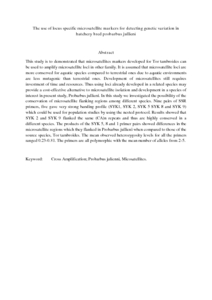Citation
Ghiasi, N. and Rashid, Z.A. and Hooshmand, S. and Yusoff, Khatijah and Tan, Soon Guan and Bhassu, S.
(2009)
The use of locus specific microsatellite markers for detecting genetic variation in hatchery bred probarbus jullieni.
Biotechnology, 8 (1).
pp. 166-170.
ISSN 1682-296X
Abstract
This study is to demonstrated that microsatellites markers developed for Tor tambroides can be used to amplify microsatellite loci in other family. It is assumed that microsatellite loci are more conserved for aquatic species compared to terrestrial ones due to aquatic environments are less mutagenic than terrestrial ones. Development of microsatellites still requires investment of time and resources. Thus using loci already developed in a related species may provide a cost-effective alternative to microsatellite isolation and development in a species of interest in present study, Probarbus jullieni. In this study we investigated the possibility of the conservation of microsatellite flanking regions among different species. Nine pairs of SSR primers, five gave very strong banding profile (SYK1, SYK 2, SYK 5 SYK 8 and SYK 9) which could be used for population studies by using the nested protocol. Results showed that SYK 2 and SYK 9 flanked the same (CA)n repeats and thus are highly conserved in a different species. The products of the SYK 5, 8 and 1 primer pairs showed differences in the microsatellite regions which they flanked in Probarbus jullieni when compared to those of the source species, Tor tambroides. The mean observed heterozygosity levels for all the primers ranged 0.23-0.81. The primers are all polymorphic with the mean number of alleles from 2-5.
Download File
![[img]](http://psasir.upm.edu.my/17360/1.hassmallThumbnailVersion/The%20use%20of%20locus%20specific%20microsatellite%20markers%20for%20detecting%20genetic%20variation%20in%20hatchery%20bred%20probarbus%20jullieni.pdf)  Preview |
|
PDF (Abstract)
The use of locus specific microsatellite markers for detecting genetic variation in hatchery bred probarbus jullieni.pdf
Download (84kB)
| Preview
|
|
Additional Metadata
Actions (login required)
 |
View Item |

